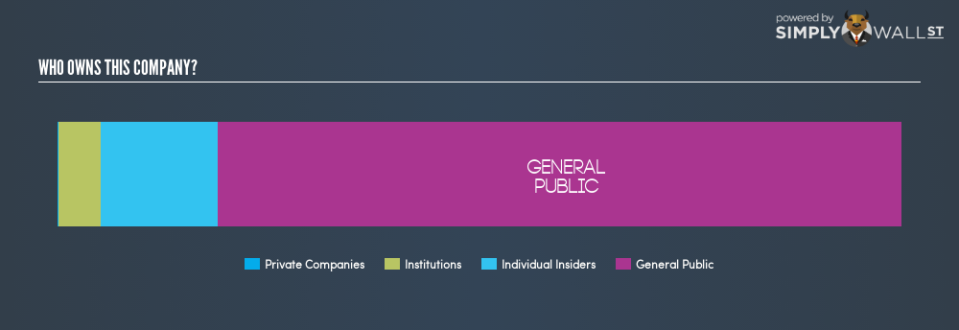Breaking Down Aptose Biosciences Inc’s (TSE:APS) Ownership Structure

In this article, I’m going to take a look at Aptose Biosciences Inc’s (TSE:APS) latest ownership structure, a non-fundamental factor which is important, but remains a less discussed subject among investors. When it comes to ownership structure of a company, the impact has been observed in both the long-and short-term performance of shares. Since the same amount of capital coming from an activist institution and a passive mutual fund has different implications on corporate governance, it is a useful exercise to deconstruct APS’s shareholder registry.
See our latest analysis for Aptose Biosciences
Institutional Ownership
Institutional investors transact in large blocks which can influence the momentum of stock prices, at least in the short-term, especially when there is a low level of public shares available on the market to trade. A low institutional ownership of 4.96% puts APS on a list of companies that are not likely exposed to spikes in volatility resulting from institutional trading.
Insider Ownership
An important group of shareholders are company insiders. Insider ownership has to do more with how the company is managed and less to do with the direct impact of the magnitude of shares trading on the market. A major group of owners of APS is individual insiders, sitting with a hefty 13.82% stake in the company. Broadly, insider ownership of this level has been found to negatively affect companies with consistently low PE ratio (underperforming). And a positive impact has been seen on companies with a high PE ratio (outperforming). Another aspect of insider ownership is to learn about their recent transactions. Insiders buying company shares can be a positive indicator of future performance, but a selling decision can simply be driven by personal financial needs.
General Public Ownership
The general public holds a substantial 80.95% stake in APS, making it a highly popular stock among retail investors. This size of ownership gives retail investors collective power in deciding on major policy decisions such as executive compensation, appointment of directors and acquisitions of businesses.
Private Company Ownership
Another important group of owners for potential investors in APS are private companies that hold a stake of 0.27% in APS. These are companies that are mainly invested due to their strategic interests or are incentivized by reaping capital gains on investments their shareholdings. However, an ownership of this size may be relatively insignificant, meaning that these shareholders may not have the potential to influence APS’s business strategy. Thus, investors not need worry too much about the consequences of these holdings.
Next Steps:
Institutional ownership in APS is not at a level that would concern investors. We are less likely to see sustained downtrends or significant volatility resulting from large institutional trading. However, if you are building an investment case for APS, ownership structure alone should not dictate your decision to buy or sell the stock. Instead, you should be evaluating company-specific factors such as the intrinsic valuation, which is a key driver of Aptose Biosciences’s share price. I urge you to complete your research by taking a look at the following:
Future Outlook: What are well-informed industry analysts predicting for APS’s future growth? Take a look at our free research report of analyst consensus for APS’s outlook.
Past Track Record: Has APS been consistently performing well irrespective of the ups and downs in the market? Go into more detail in the past performance analysis and take a look at the free visual representations of APS’s historicals for more clarity.
Other High-Performing Stocks: Are there other stocks that provide better prospects with proven track records? Explore our free list of these great stocks here.
NB: Figures in this article are calculated using data from the last twelve months, which refer to the 12-month period ending on the last date of the month the financial statement is dated. This may not be consistent with full year annual report figures.
To help readers see past the short term volatility of the financial market, we aim to bring you a long-term focused research analysis purely driven by fundamental data. Note that our analysis does not factor in the latest price-sensitive company announcements.
The author is an independent contributor and at the time of publication had no position in the stocks mentioned. For errors that warrant correction please contact the editor at editorial-team@simplywallst.com.

 Yahoo Finance
Yahoo Finance 
